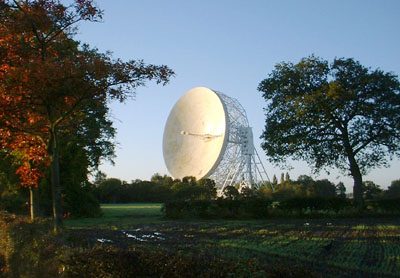The Lovell Telescope - Forward into the 21st Century

The Lovell Telescope prior to the surface upgrade, March 2001
Credit: A.Holloway, University of Manchester
The University of Manchester has been awarded a grant from the Joint Infrastructure Fund (JIF) to fund a ?2M upgrade of its world famous Lovell Telescope at the Jodrell Bank Observatory. The improvements in both sensitivity and frequency range will extend the operational life of the telescope, taking it into a second half-century at the forefront of astronomical research with as much promise and potential as when it was first built.
The University of Manchester's giant 76-metre (250ft) Lovell radio telescope at Jodrell Bank is probably the most famous working scientific instrument in the land and is widely regarded by the public as an icon of the very best achievements of British science and technology. For over 40 years, the telescope, still the second largest fully-steerable radio telescope in the world, has played a major role in astronomical research due to its large collecting area and great flexibility. Equipped with state-of-the-art receiver systems, the telescope is now 30 times more sensitive than when it was first built. In recent years it has played a leading role in many fields of astronomy, including the detection and study of a new population of pulsars and the discovery of the first gravitational lens. It is also currently attracting great public interest through its participation in the most sensitive search ever for signals from extra-terrestrial intelligence.
The upgraded Lovell Telescope will retain the full versatility of the present instrument. An expansion of the useable frequency range by a factor of four and an increase in the sensitivity at the key operational frequency of 5 GHz by a factor of five will allow a wide range of new science to be carried out. As a stand-alone instrument it is expected that the upgraded Lovell Telescope will be used to discover new distant pulsars, make a census of star-formation sites in the Galaxy through the observation of the spectral lines of formaldehyde, excited hydroxyl (OH) and methanol molecules and conduct a very deep survey for faint extra-galactic radio sources and galactic radio stars.
In addition to its use as a single telescope, the Lovell Telescope is a key element of the UK's MERLIN high resolution radio-imaging National Facility. The enhancement will increase the sensitivity of MERLIN by up to a factor of three and will open up exciting new areas of astrophysical study at a resolution which exceeds that of the Hubble Space Telescope (HST) and is matched to that of the planned next generation of telescopes in other wavebands. The Lovell telescope is also regularly linked to telescopes in Europe and around the globe to make observations with the highest resolution in all astronomy. Its contribution to this research will be greatly enhanced, with the upgraded telescope able to play a significant role in the expansion of these activities into space. Major advances can be expected in the investigation of objects ranging from nearby stars in the Milky Way to the most distant galaxies and quasars. However, as in the past, the most important and exciting discoveries by the telescope will be those which are totally unpredictable.
The upgrade package has four main elements, with the work planned to be carried out over the summers in 2000 to 2002 at a fraction of the cost (at least ?30M) of building a new telescope of the same size and comparable performance.
New reflecting surface
The present surface panels will be replaced by new galvanised steelplate. Attachment will be with self tapping screws to avoid thermal distortions of the type induced in the present surface by spot welding.
Surface adjustment
Using modern holographic profiling techniques, the newsurface will be set to optimise the efficiency of the telescope for operation at frequencies above 5 GHz.
New pointing control system
The present drive and control system will be replaced by state-of-the-art technology to increase the precision of the positional control. This will involve independent control of individual drive motors.
Refurbishment of the track and foundations
Remedial work on the surface layer of the foundations has been carried out as recommended by specialists to prevent water ingress. The outer azimuthal track has been relaid to the current British standard.


